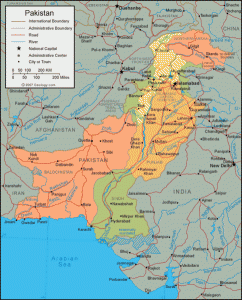Friday Day of Reckoning: Pakistan Declares Holiday to Protest Film; France Closes Outposts After Cartoon Published
What could possibly go wrong? From a Dawn article only an hour or two old:
The Pakistani government has announced a national holiday on Friday to protest against the American anti-Islam [sic] that has caused an outrage throughout the Muslim world.
The federal cabinet decided to make Friday an official “day of expression of love for the prophet” after discussing the “Innocence of Muslims” movie, which has triggered more than a week of violent protests across the Islamic world, a senior government official said.
The move came after religious parties called for a day of protest on Friday to denounce the film.
Interior Minister Rehman Malik, while speaking to media representatives earlier today, said that the Pakistan People’s Party (PPP) would join protestors in their demonstrations.
The head of the Sunni Tehreek religious party on Monday urged people across the country to close their businesses and hold rallies against the film, which was made in the United States.
As if the furor over the video weren’t enough on its own, a French magazine is fanning the flames by publishing a new Mohammad cartoon, and in response France is closing a number of embassies and international schools on Friday:
A French magazine ridiculed the Prophet Mohammad on Wednesday by portraying him naked in cartoons, threatening to fuel the anger of Muslims around the world who are already incensed by a film depicting him as a womanizing buffoon.
The French government, which had urged the magazine not to print the images, said it was temporarily shutting down premises including embassies and schools in 20 countries on Friday, when protests sometimes break out after Muslim prayers.
Riot police were deployed to protect the Paris offices of satirical weekly Charlie Hebdo after it hit the news stands with a cover showing an Orthodox Jew pushing the turbaned figure of Mohammad in a wheelchair. On the inside pages, several caricatures of the Prophet showed him naked.
We are now well beyond the realm of “spontaneous” reaction to a single provocative and poorly produced video. When governments nearly half a world apart take actions two days in advance of anticipated demonstrations that seem virtually guaranteed to descend into violence, then somehow the actions of a few demented agitators in the West and a few demented religious zealots in Asia and the Middle East seem to have achieved their goals of bringing even more chaos to a troubled world.
Are the demented agitators in the West just a handful of losers working independently toward a shared goal, or are there hidden forces providing financial and logistic support? Sadly, Pakistan is showing by its actions that they are allowing religious zealots to have too much power over their government. This should serve as a warning to those who would decrease the separation of church and state in the US, but don’t look for that lesson to be learned any time soon.
Friday seems virtually guaranteed to be ugly.

